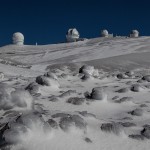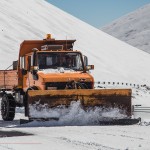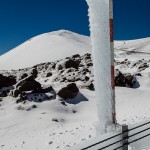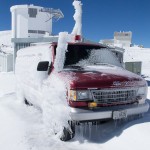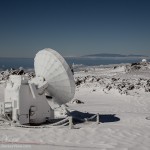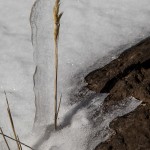The instruments were warming up. Liquid nitrogen exhausted, cooling interrupted by loss of power, the cryogenic dewars had begun to warm. Recovering instruments takes many days of vacuum pumps and re-cooling to restore function if cooling has been loss. Other problems caused by the storm and power outages plagued the summit, some systems not responding to remote queries.

Sunday offered at least a hope of making it to the summit. The storm had abated and beautiful sunny skies appeared over the summit. We readied for an attempt at the summit of Mauna Kea. As the engineer on call I would join the support techs at the summit. Maybe we could salvage something from the chaos.
I did not even head for the summit until mid-day. I knew that it would take hours for the plows to reach our telescope. A few hours of sunshine would be useful as well. As the plows expose the asphalt, the sunlight quickly warms the pavement and melts the ice, turning the last layer of ice to slush.
Arriving at Hale Pohaku I learn the Ray and Joe had departed just before noon for their attempt. I head up after them, knowing that I would either find them at the telescope or pass them heading back down. It was the latter, we met just below where the pavement begins They had found that the road was impassable and that the plows had not yet attempted to reach Keck.
I was nearly at the top, may as well finish my climb. I drove to the end of the plowed road to park at the JCMT driveway. The plow crews were working the lower roads and starting the summit ridge. I walked up past SMA to the back road to Subaru and Keck, the route we use in bad weather. It was a sheet of ice, treacherous to even walk on. Not a chance of making it safely to the telescopes, not without undue risk or mountain climbing gear.
It was also stunningly beautiful. I pulled the camera from my pack, and started shooting. I slowly worked my way back down the mountain taking photos. I chatted with the plow crews. They reported slow going, multiple passes needed to break through the ice and clear a safe road.
The mountain may look white and snowy from a distance, but from up close that illusion of friendly fluffy snow turns to the reality of mostly ice and a little snow. Every vertical surface, every rock is coated in multiple inches of ice. The result is impressive, a world of ice. The camera memory card begins to fill rapidly. Every direction you look is another photo opportunity.
After returning home I found that the crews did eventually reach Keck at the very end of the day. I would not have not expected them to do so until tomorrow morning. Too late, the instruments are warm, we will begin recovery with the new week. We may have failed to reach the telescopes, but I was glad I went. The photos are rather nice…

